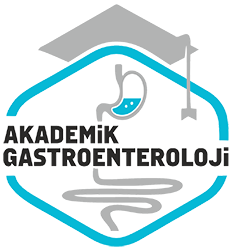Nisan 2022
Proksimal özofagusta heterotopik gastrik mukozal yama saptanan çocuklarin değerlendirilmesi
Evaluation of children with heterotopic gastric mucosal patch in the proximal esophagus
- Ana Sayfa
- Sayılar
- Nisan 2022
- Proksimal özofagusta heterotopik gastrik mukozal yama saptanan çocuklarin değerlendirilmesi...
Özet
ÖZET • Giriş ve Amaç: Ilk olarak 1805 tarihinde Schmidt tarafindan tanımlanan “inlet patch” (heterotopik gastrik mukoza) özofagus proksimaline yerlesmis ektopik mide mukoza adasidir. Farkli olusum teorileri vardır. Makroskopik olarak oval, pembemsi somon renginde kadifemsi görünümde normal mukozadan keskin sinirla ayri- lan, farkli boyutlarda olan, nadiren özofagusu çevreleyen heterotopik gastrik mukoza arka ya da yan duvarda, tek veya multiple parçalar halinde görülebilir. Çogunlukla asemptomatik olup, supraözofageal, özofageal, solunum ve gastrointestinal semptomlarla kendini gösterebilir. Özofagogastroduodenoskopi sırasında hizla özofagus girilip çikildigi için kolaylikla gözden kaçabilir, bu nedenle insidans ve prevalansi düşüktür. Çesitli nedenlere bagli olarak özofagogastroduodenoskopide sikligi %0.1-10 arasında degismektedir. Pediatrik grupta yapilmis genis kapsamli çalışma olmadigi için 18 yaş altı farkli nedenlerle özofagogastroduodenoskopi yapilarak heterotopik gastrik mukoza saptanan çocuklarin demografik ve klinik özellikleri, prevalansi, makroskopik ve histolojik özellikleri belirlenerek literatür esliginde sunmak amaçlanmıştır. Gereç ve Yöntem: Ekim 2017 ve Aralık 2020 tarihleri arasında 18 yaş altında özofagogastroduodenoskopi yapilarak heterotopik gastrik mukoza tanısı konan çocuk hastalar çalışmaya dahil edildi. Bulgular: çalışmada özofagogastroduodenoskopi yapılan 2500 çocuk hastanın 30’unda (%1.2) heterotopik gastrik mukoza saptandi. Hastaların yarisi erkek, ortama yaş 13.4 yıl, En sık başvuru şikayeti %75 ile karın ağrısıydi. Eslik eden diğer şikayetler ise; %45.8 disfaji, %12.5 hemoptizi, %8.3 pirozis ve %8.3 regürjitasyondu. Laboratuvar incelemelerinde %37.5 vitamin B12 eksikliği, %33.3 demir eksikliği anemisi vardı. Lezyonlar özofagusta 5-17. cm arasında, 5 - 50 mm çapinda (En sık 5 - 10 mm, %53.4), tek ve multiple sayida (En sık 1 adet, %79.1), somon kirmizisi pembe kadifemsi görünümdeydi. Özofagogastroduodesnokopide %66.6 hastada nodüler gastrit, %8.3 peptik ülser; histopatolojide %45.8 Helicobacter pylori gastriti saptandi. Tiplerine göre değerlendirildiginde tip 2 heterotopik gastrik mukoza %83.3, tip 3 heterotopik gastrik mukoza %16.6, tip 4 heterotopik gastrik mukoza %4’tü. Tip 1 ve tip 5 saptanmadi. Komplikasyon olarak tanı aninda 1 hastada darlikla beraber ülser, 3 hastada hemoptizi seklinde kanama vardı. Hastaların bir yıllik takip sürelerinde medikal tedavi dışında argon lazer ve ek tedavi ihtiyaci olmadi. Sonuç: Çocuklarda nadir görülse de heterotopik gastrik mukoza metaplazi riski olmasi nedeniyle göz ardi edilmemelidir. Semptomu olan hastalarda üst özofagustan yavas ve dikkatli geçilmeli, üst özofagus sfinkterinin hemen alti mutlaka değerlendirilmelidir. Islemin deneyimli bir endoskopist tarafindan yapilmasi tanısal açidan çok önemlidir. Çocuklarda heterotopik gastrik mukozanin anlasilmayan birçok kismini netlestirmek için daha fazla çalışmaya ihtiyaç vardır.
Abstract
ABSTRACT • Background and Aims: The inlet patch is an island of ectopic gastric mucosa located proximal to the esophagus. It was first described by Schmidtin 1805. Different theories have been proposed about its formation. The heterotopic gastric mucosa is macroscopically oval, velvety, and pinkish salmon in color. It isdistinctly separated from the normal mucosa and has different sizes. It rarely surrounds the esophagus. It can be seen on the back or side walls of the esophagus as asingle piece or multiple pieces. It is mostly asymptomatic and can present with supraesophageal, esophageal, respiratory, and gastrointestinal symptoms. During esophagogastroduodenoscopy, it can be easily overlooked when the esophagus passed quickly. Therefore, its incidence and prevalence are low. The frequency of detectionof the inlet patch by esophagogastroduodenoscopy varies between 0.1% and 10% depending on the reasons it was performed. Moreover, no comprehensive studieshave been conducted in pediatric patients. Therefore, children aged 18 years who were found to have heterotopic gastric mucosa by esophagogastroduodenoscopy,performed for different reasons, were included the study. In this study, we aimed to determine the prevalence of heterotopic gastric mucosa and study its demographic,clinical, macroscopic, and histological features for presenting them in the light of the literature. Materials and Methods: The study included pediatric patients aged<18 years who were diagnosed with heterotopic gastric mucosa by esophagogastroduodenoscopy between October 2017 and December 2020. Patients’ clinical datawere retrospectively reviewed. Results: In this study, heterotopic gastric mucosa was detected in 30 (1.2%) out of 2,500 pediatric patients that underwent esophagogastroduodenoscopy. Half of the patients were male, and the mean age was 13.4 years. The most common complaint was abdominal pain in 75%. Other accompanyingcomplaints were dysphagia in 45.8%, hemoptysis in 12.5%, and heartburn and regurgitation in 8.3%. Laboratory evaluations revealed vitamin B12 deficiency and irondeficiency anemia in 37.5% and 33.3% of the patients, respectively. In the esophagus, the lesions ranged from 5 to 17 cm, 5–50 mm in diameter (most commonly 5–10mm: 53.4%), single and multiple (most commonly single in 79.1%), and with salmon red or pink velvety appearance. In esophagogastroduodenoscopy, nodular gastritisand peptic ulcers were detected in 66.6% and 8.3% of the patients, respectively. Histopathologically, Helicobacter pylori gastritis was detected in 45.8% of the patients.Cases were reviewed according to subtypes: 83.3% had type 2 heterotopic gastric mucosa, 16.6% had type 3, and 4% had type 4. No cases of types 1 and 5 were found.At diagnosis, one patient had stricture and ulcer and three patients had hemoptysis as complications. Patients were followed up for 1 year, and none of them neededargon laser or additional therapies. Conclusions: Heterotopic gastric mucosa is rare in children; however, it should not be ignored because of the risk of metaplasia. Inpatients with suggestive symptoms, the upper esophagus should be examined slowly and carefully, and the area just below the upper esophageal sphincter should beevaluated cautiously. To obtain a specific diagnosis, esophagogastroduodenoscopy must be performed by experienced endoscopists. As many causes of heterotopicgastric mucosa in children are not understood, further studies are needed



